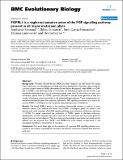Files in this item
FGFRL1 is a neglected putative actor of the FGF signalling pathway present in all major metazoan phyla
Item metadata
| dc.contributor.author | Bertrand, Stephanie | |
| dc.contributor.author | Somorjai, Ildiko | |
| dc.contributor.author | Garcia-Fernandez, Jordi | |
| dc.contributor.author | Lamonerie, Thomas | |
| dc.contributor.author | Escriva, Hector | |
| dc.date.accessioned | 2014-04-28T10:01:05Z | |
| dc.date.available | 2014-04-28T10:01:05Z | |
| dc.date.issued | 2009-09-09 | |
| dc.identifier | 34019817 | |
| dc.identifier | f46c275f-e8eb-4da0-af3e-02fc0a65044b | |
| dc.identifier | 000270359100001 | |
| dc.identifier | 70350327764 | |
| dc.identifier.citation | Bertrand , S , Somorjai , I , Garcia-Fernandez , J , Lamonerie , T & Escriva , H 2009 , ' FGFRL1 is a neglected putative actor of the FGF signalling pathway present in all major metazoan phyla ' , BMC Evolutionary Biology , vol. 9 , 226 . https://doi.org/10.1186/1471-2148-9-226 | en |
| dc.identifier.issn | 1471-2148 | |
| dc.identifier.other | ORCID: /0000-0001-5243-6664/work/46168677 | |
| dc.identifier.uri | https://hdl.handle.net/10023/4625 | |
| dc.description | Association pour la Recherche contre le Cancer, Centre National de la Recherche Scientifique, the European Molecular Biology Organization, and the Cascade network of excellence in the 6th Framework Programme for financial support. The laboratory of HE is supported by the Cascade EU Network of Excellence and Agence Nationale de la Recherche. The laboratory of JGF is supported by BMC2008-03776 (Ministerio de Educación y Ciencia). IS' postdoctoral position was supported by a CNRS fellowship. SB's postdoctoral position was supported by an ARC fellowship. | en |
| dc.description.abstract | Background: Fibroblast Growth Factors (FGF) and their receptors are well known for having major implications in cell signalling controlling embryonic development. Recently, a gene coding for a protein closely related to FGFRs (Fibroblast Growth Factor Receptors) called FGFR5 or FGFR-like 1 (FGFRL1), has been described in vertebrates. An orthologous gene was also found in the cephalochordate amphioxus, but no orthologous genes were found by the authors in other non-vertebrate species, even if a FGFRL1 gene was identified in the sea urchin genome, as well as a closely related gene, named nou-darake, in the planarian Dugesia japonica. These intriguing data of a deuterostome-specific gene that might be implicated in FGF signalling prompted us to search for putative FGFRL1 orthologues in the completely sequenced genomes of metazoans. Results: We found FGFRL1 genes in the cnidarian Nematostella vectensis as well as in many bilaterian species. Our analysis also shows that FGFRL1 orthologous genes are linked in the genome with other members of the FGF signalling pathway from cnidarians to bilaterians (distance < 10 Mb). To better understand the implication of FGFRL1 genes in chordate embryonic development, we have analyzed expression patterns of the amphioxus and the mouse genes by whole mount in situ hybridization. We show that some homologous expression territories can be defined, and we propose that FGFRL1 and FGF8/17/18 were already co-expressed in the pharyngeal endoderm in the ancestor of chordates. Conclusion: Our work sheds light on the existence of a putative FGF signalling pathway actor present in the ancestor of probably all metazoans, the function of which has received little attention until now. | |
| dc.format.extent | 14 | |
| dc.format.extent | 1503870 | |
| dc.language.iso | eng | |
| dc.relation.ispartof | BMC Evolutionary Biology | en |
| dc.subject | QL Zoology | en |
| dc.subject | QH426 Genetics | en |
| dc.subject.lcc | QL | en |
| dc.subject.lcc | QH426 | en |
| dc.title | FGFRL1 is a neglected putative actor of the FGF signalling pathway present in all major metazoan phyla | en |
| dc.type | Journal article | en |
| dc.contributor.institution | University of St Andrews. School of Biology | en |
| dc.contributor.institution | University of St Andrews. Marine Alliance for Science & Technology Scotland | en |
| dc.contributor.institution | University of St Andrews. Biomedical Sciences Research Complex | en |
| dc.identifier.doi | 10.1186/1471-2148-9-226 | |
| dc.description.status | Peer reviewed | en |
| dc.identifier.url | http://www.biomedcentral.com/1471-2148/9/226 | en |
This item appears in the following Collection(s)
Items in the St Andrews Research Repository are protected by copyright, with all rights reserved, unless otherwise indicated.

